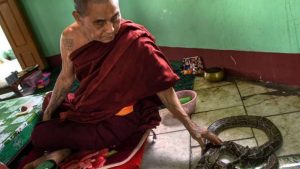The Buddhist population in Bangladesh is comprised of diverse ethnic groups, including the Barua, Chakma, Tanchangya, Marma, and Rakhain peoples. These groups mostly profess belief in Theravada Buddhism. The Buddhist community in Bangladesh is estimated to be around a million people, representing approximately 0.6 per cent of the country’s total population.
However, a minor Theravada-like community known as the Luris seems to defy neat categories, since its members practice a syncretic form of Buddhism that incorporates elements of Theravada, tantric traditions, and indigenous cults. The Luris reside within the Chittagong Hill Tracts (CHT) and were recognized as prominent practitioners of Buddhism in the CHT, especially among the Chakma people. Notably, Francis Buchanan documented these religious leaders as follows: “They have two ranks of priests, the Samona and Moishang, the latter of whom are the superiors and by Bengalese are called Raulins. (Schendel 1992,108)

The Barua community once had people among them called “Raulis,” but they no longer exist as a demographic today. The Luri movement in the Chittagong Hill Tracts (CHT) is small due to the dominance of Theravada Buddhism among many of the ethnic groups. Sumananda Luri, a young and energetic Luri monk, said that there are 22 temples, 17 priests, and about 4,000 followers in the CHT, with a similar number in Tripura near the border in India.
Although contemporary Luris resemble Theravada monks, they actually identify as Mahayana Buddhists and conduct rituals similar to Theravada practices. Recently, they have added the statue of Amitabha Buddha to the statue of the Gautama Buddha in their temples, in order to emphasize their Mahayana identity.
Common followers of Luris undergo a three-day initiation called samanira. Before concluding their samanira period, they visit several homes in the morning to collect alms, known as bilem. Unlike Theravada monks, as bilem the Luris accept items such as rice, potatoes, vegetables, biscuits, packaged foods, and money, but not cooked rice or curry.
To become a samanira, one must be at least seven years old and remain in this status for four months to four years at a temple. After mastering the teachings, he becomes a thors (similar to a bhikkhu) and travels to preach in different places.
In earlier times, many Luris chose to live in cottages away from the village to focus on advanced meditation practices. Eventually, the Luris formed the Bangladesh Mahayana Luri Sangha, living together with disciples and following a routine of early morning worship to Gozen, meaning Lord or Creator in Chakma folklore. According to Sumananda Luri, Gozen is also another name of the Buddha. Over time, the Luris adopted a more structured lifestyle with strict guidelines for the sangha, enforcing severe consequences, including expulsion, for violations of the rules. This is very similar to conventional Buddhist Vinaya orthodoxy.
The Luri community engages in various Theravada Buddhist ceremonies alongside monks, and values strong relationships with them. They celebrate most Buddhist events, such as Vesak, similar to Theravada Buddhists in Bangladesh. Extraordinarily, they do not observe the three-month rains retreat. While other Buddhists celebrate the Kathina robe-offering followed after rains retreat, the Luris call it Tri-civar Dan (offering of three-set of robes).
Their rituals include reciting sutras or mantras from their text, the Agartara, which has 28 Tibetan-Burmese-style written in a script resembling Shan in Burma, and is influenced by Pali and Sanskrit.
A handwriting of the manuscript of the Agartara by Babu Angu Phul Karbari, composed in 1964, is preserved at the Rangamati Tribal Cultural Institute. An analysis of the Agartara, titled Cakmadar Pracin Dharmagrantha Agharatara Bisleshan, was published in 2006. Indralal Chakma translated Malentara into Bengali, featuring 21 gathas.

The Luris believe that the Buddha gave the Agartara text to his son Rahula, marking the start of the Mahayana Luri tradition. Each tara or chapter holds specific religious significance:
Agar Tara: religious scripture
Malen Tara: used in ceremonies similar to the Maagala Sutta
Sadheagiri Tara: related to King Sadhengiri, used in funerals
Anija (anicca) Tara: discusses impermanence, recited during offerings for the deceased
Sila Mangal Tara: used for protection from various harms
Dasa Parami Tara: pertains to the ten perfections, used in alms donation
Jayamangala Tara: similar to the Jayamangala Sutta, recited at weddings.
The language of the Agartara has been shaped by influences from various linguistic traditions. It is therefore very difficult to understand. German Indologist Heinz Bechert commented on the text:
The Language of these books is not understood today and they are written in Chakma Alphabets which shows similarities to Shan earlier Burmese alphabets, from an analysis of these texts it becomes clear that they consist of excerpts from pali texts and passages in an unknown language. The Extreme distortion of the text in the manuscript available today has made impossible so far to classify this language beyond doubt. (Cakma, ed. 2004, 7)
The term “Luri” and its religious practices are said to have emerged during the reign of Burmese King Anawrahta (1014–77), a proponent of Theravada Buddhism in Burma. During his rule, King Anawrahta expelled a group of Buddhist priests referred to as “Ari” from Arakan, who adhered to Mahayana Buddhism and engaged in tantric rituals. (Ray 1936, 66)
It is conceivable that some of them may have resettled in CHT due to the robust social, religious, cultural, and anthropological ties between the inhabitants of CHT and Burma. The observations of traveler Francis Buchanan during his 1798 visit to CHT to substantiate their presence. Buchanan recounted his experience at a Buddhist temple, where he observed a monk instructing young boys in literacy skills. To quote Buchanan:
In a corner of this apartment were a few small images, clothed in yellow, but in a posture different from that of the Burma Godama. . . . The priest was intelligent kind of man, and had come from Arakan. . . . This priest however had some very fine copies of the Book Kam-mua; but perhaps the Rakhain Edition of that book differ from the Burma, as I found, that there exited many differences in the religious Doctrines of the two people. . . . This priest believed in Brimmah, or the Supreme being; . . . The sect of this priest believe in the some Moonies or, Gods, that are alleged by the Burmas to have appeared in this world; namely Chaucasam, Gonagom, Gaspa and Godama, but to these they add name Mahamoony. (Schendel, ed. 1992, 87–92)
The Luris, while identifying themselves as part of Mahayana Buddhism, currently lack ties to Mahayana Buddhism and its teachings. It is plausible that during the decline of Buddhism in Bengal, some individuals adopted a hybrid practice that incorporated local cultural elements, leading to the formation of the Luri community. Although they may have been historically influenced by tantric Buddhism, the Luris have forged their own distinct religious traditions that set them apart from contemporary forms of Buddhism.
Despite their dwindling numbers, the Luris hold a significant place in the history of Buddhism in Bangladesh, making it essential to preserve their history and cultural heritage before they fade into obscurity due to the strong influence by contemporary Theravada Buddhism.
References
Cakma, Inrdra Lal, ed. 2004. Malentara Orthosar. Rangamati, Majhervasti.
Ray, Nihar Ranjan. 1936. Sanskrit Buddhism in Burma. Calcutta: University of Calcutta.
Schendel, Willem van., ed. 1992. Francis Buchanon in South-east Bengal (1798): His Journey to Chittagong, the Chittagong Hill Tracts, Noakhali and Comilla. Dhaka: The University Press Limited.
Related features from BDG
Ramu Attacks: One Decade On, Bangladeshi Buddhists Still Hope for Justice
Buddhist Heritage, Old and Modern: The Ancient and New Shalban Vihars in Bangladesh
From Bangladesh to Korea: Struggles and Successes on the Path to Female Monasticism
From Bangladesh to Hong Kong: Connecting Buddhist Cultures through the Tradition of Annaprashan
US Department of State Honors Bangladeshi Social Activist Rani Yan Yan with 2023 Global Anti-Racism Champions Award
Buddhist Women’s Orders Return to their Ancestral Motherlands: First International Theravada Bhikkhuni Ordination in Bangladesh
Related news reports from BDG
Archaeologists in Bangladesh Unearth Ancient Buddhist University Pandit Vihar
Interfaith Minority Council in Bangladesh Calls for Fair and Violence-Free National Election
Hindu Buddhist Christian Unity Council Seeks Greater Representation in Bangladesh
Rakhine Community in Bangladesh Protests Myanmar’s Military Aggression in Rakhine State















